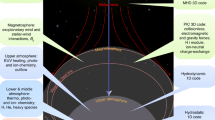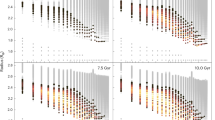Abstract
During the dawn of chemistry1,2, when the temperature of the young Universe had fallen below some 4,000 kelvin, the ions of the light elements produced in Big Bang nucleosynthesis recombined in reverse order of their ionization potential. With their higher ionization potentials, the helium ions He2+ and He+ were the first to combine with free electrons, forming the first neutral atoms; the recombination of hydrogen followed. In this metal-free and low-density environment, neutral helium atoms formed the Universe’s first molecular bond in the helium hydride ion HeH+ through radiative association with protons. As recombination progressed, the destruction of HeH+ created a path to the formation of molecular hydrogen. Despite its unquestioned importance in the evolution of the early Universe, the HeH+ ion has so far eluded unequivocal detection in interstellar space. In the laboratory the ion was discovered3 as long ago as 1925, but only in the late 1970s was the possibility that HeH+ might exist in local astrophysical plasmas discussed4,5,6,7. In particular, the conditions in planetary nebulae were shown to be suitable for producing potentially detectable column densities of HeH+. Here we report observations, based on advances in terahertz spectroscopy8,9 and a high-altitude observatory10, of the rotational ground-state transition of HeH+ at a wavelength of 149.1 micrometres in the planetary nebula NGC 7027. This confirmation of the existence of HeH+ in nearby interstellar space constrains our understanding of the chemical networks that control the formation of this molecular ion, in particular the rates of radiative association and dissociative recombination.
This is a preview of subscription content, access via your institution
Access options
Access Nature and 54 other Nature Portfolio journals
Get Nature+, our best-value online-access subscription
$29.99 / 30 days
cancel any time
Subscribe to this journal
Receive 51 print issues and online access
$199.00 per year
only $3.90 per issue
Buy this article
- Purchase on Springer Link
- Instant access to full article PDF
Prices may be subject to local taxes which are calculated during checkout


Similar content being viewed by others
Data availability
The data presented here are available through the SOFIA data archive at https://dcs.arc.nasa.gov/ and can be retrieved by searching for the project identification code, 83_0405.
References
Galli, D. & Palla, F. The dawn of chemistry. Annu. Rev. Astron. Astrophys. 51, 163–206 (2013).
Lepp, S., Stancil, P. C. & Dalgarno, A. Atomic and molecular processes in the early Universe. J. Phys. B 35, R57–R80 (2002).
Hogness, T. R. & Lunn, E. G. The ionization of hydrogen by electron impact as interpreted by positive ray analysis. Phys. Rev. 26, 44–55 (1925).
Drabowski, I. & Herzberg, G. The predicted infrared spectrum of HeH+ and its possible astrophysical importance. Ann. NY Acad. Sci. 38, 14–25 (1977).
Black, J. H. Molecules in planetary nebulae. Astrophys. J. 222, 125–131 (1978).
Flower, D. R. & Roueff, E. On the formation and destruction of HeH+ in gaseous nebulae and the associated infra-red emission line spectrum. Astron. Astrophys. 72, 361–366 (1979).
Roberge, W. & Dalgarno, A. The formation and destruction of HeH+ in astrophysical plasmas. Astrophys. J. 255, 489–496 (1982).
Heyminck, S. et al. GREAT: the SOFIA high-frequency heterodyne instrument. Astron. Astrophys. 542, L1 (2012).
Risacher, C. et al. First supra-THz heterodyne array receivers for astronomy with the SOFIA observatory. IEEE Trans. Terahertz Sci. Technol. 6, 199–211 (2016).
Young, E. T. et al. Early science with SOFIA, the Stratospheric Observatory for Infrared. Astrophys. J. 749, L17 (2012).
Masson, C. R. The structure of NGC 7027 and a determination of its distance by measurement of proper motions. Astrophys. J. 336, 294–303 (1989).
Zijlstra, A. A., van Hoof, P. A. M. & Perley, R. A. The evolution of NGC 7027 at radio frequencies: a new determination of the distance and core mass. Astrophys. J. 681, 1296–1309 (2008).
Cecchi-Pestellini, C. & Dalgarno, A. Emission of HeH+ in nebulae. Astrophys. J. 413, 611–618 (1993).
Moorhead, J. M., Lowe, R. P., Maillard, J.-P., Wehlau, W. H. & Bernath, P. F. Search for HeH+ in NGC 7027. Astrophys. J. 326, 899–904 (1988).
Dinerstein, H. L. & Geballe, T. R. Detection and significance of [Zn IV] 3.625 microns in planetary nebulae. Astrophys. J. 562, 515–520 (2001).
Liu, X.-W. et al. An ISO long wavelength spectrometer detection of CH in NGC 7027 and a HeH+ upper limit. Mon. Not. R. Astron. Soc. 290, L71–L75 (1997).
Miller, S., Tennyson, J., Lepp, S. & Dalgarno, A. Identification of features due to H3 + in the infrared spectrum of supernova 1987A. Nature 355, 420–422 (1992).
Zinchenko, I., Dubrovich, V. & Henkel, C. A search for HeH+ and CH in a high-redshift quasi-stellar object. Mon. Not. R. Astron. Soc. 415, L78–L80 (2011).
Loreau, J., Vranckx, S., Desouter-Lecomte, M., Vaeck, N. & Dalgarno, A. Photodissociation and radiative association of HeH+ in the metastable triplet state. J. Phys. Chem. A 117, 9486–9492 (2013).
Zicler, E. et al. Search for hydrogen-helium molecular species in space. Astron. Astrophys. 607, A61 (2017).
Perry, A. J., Hodges, J. N., Markus, C. R., Kocheril, G. S. & McCall, B. J. High precision sub-Doppler infrared spectroscopy of the HeH+ ion. J. Chem. Phys. 141, 101101 (2014).
Risacher, C. et al. The upGREAT 1.9 THz multi-pixel high resolution spectrometer for the SOFIA Observatory. Astron. Astrophys. 595, A34 (2016).
Basart, J. P. & Daub, C. T. Temperature and emission-measure distributions for several planetary nebulae. Astrophys. J. 317, 412–422 (1987).
Ferland, G. J. et al. The 2013 Release of Cloudy. Rev. Mex. Astron. Astrofis. 49, 137–163 (2013).
Vranckx, S., Loreau, J., Desouter-Lecomte, M. & Vaeck, N. Determination of photodissociation and radiative association cross sections from the same time-dependent calculation. J. Phys. B 46, 155201 (2013).
Novotný, O. et al. Dissociative recombination measurements of HCl+ using an ion storage ring. Astrophys. J. 777, 54–68 (2013).
Strömholm, C. et al. Dissociative recombination and dissociative excitation of 4HeH+: absolute cross sections and mechanisms. Phys. Rev. A 54, 3086–3094 (1996).
Čurík, R. & Greene, C. H. Inelastic low-energy collisions of electrons with HeH+. J. Chem. Phys. 147, 054307 (2017).
Pütz, P., Büchel, D., Jacobs, K., Schultz, M. & Honingh, C. 1.9 THz waveguide HEB mixers for the upGREAT low frequency array. In Proc. 26th Int. Symp. Space THz Technology (eds Blundell, R. & Mehdi, I.) (Cambridge, MA, USA, 2015)
Klein, B. et al. High-resolution wide-band fast Fourier transform spectrometers. Astron. Astrophys. 542, L3 (2012).
Guan, X. et al. GREAT/SOFIA atmospheric calibration. Astron. Astrophys. 542, L4 (2012).
Müller, H. S. P., Schlöder, F., Stutzki, J. & Winnewisser, G. The Cologne Database for Molecular Spectroscopy, CDMS: a useful tool for astronomers and spectroscopists. J. Mol. Struct. 742, 215–227 (2005).
Davidson, S. A., Evenson, K. M. & Brown, J. M. A measurement of the rotational spectrum of the CH radical in the far-infrared. Astrophys. J. 546, 330–337 (2001).
Matsushima, F., Oka, T. & Takagi, K. Observation of the rotational spectra of 4HeH+, 4HeD+, 3HeH+, and 3HeD+. Phys. Rev. Lett. 78, 1664–1666 (1997).
Bovino, S., Tacconi, M., Gianturco, F. A. & Galli, D. Ion chemistry in the early universe. Revisiting the role of HeH+ with new quantum calculations. Astron. Astrophys. 529, A140 (2011).
Stancil, P. C., Lepp, S. & Dalgarno, A. The deuterium chemistry of the early Universe. Astrophys. J. 509, 1–10 (1998).
Zygelman, B. & Dalgarno, A. The radiative association of He+ and H. Astrophys. J. 365, 239–240 (1990).
Acknowledgements
upGREAT is a development by the Max-Planck Institut (MPI) für Radioastronomie and the Kölner Observatorium für SubMillimeter Astronomie (KOSMA)/Universität zu Köln, in cooperation with the Deutsches Zentrum für Luft- und Raumfahrt (DLR; German Aerospace Center) Institut für Optische Sensorsysteme. The development of upGREAT is financed by the participating institutes, by the German Aerospace Center (DLR) under grants 50 OK 1102, 1103 and 1104, and within the Collaborative Research Centre 956, funded by the Deutsche Forschungsgemeinschaft (DFG). The work of D.N. was supported by grant 120364 from NASA’s Astrophysical Data Analysis Program (ADAP). SOFIA is jointly operated by the Universities Space Research Association (USRA), under NASA contract NAS2-97001, and the Deutsches SOFIA Institut (DSI), under DLR contracts 50 OK 0901 and 50 OK 1301 to the University of Stuttgart. We thank the SOFIA operations and engineering teams for their dedication and supportive responses to our requests, and E. Young and G. Sandell for making these observations possible. We are grateful to O. Novotny for recomputing the thermal rate coefficient for the dissociative recombination of HeH+, using published experimental merged-beam cross-section measurements in the literature27. We thank J. Loreau for providing published cross-section calculations for the radiative association reaction (reaction (1)) in tabular form, and for clarifying that these cross-sections apply specifically to collisions of H (1s) and He+ (1s) in the singlet state.
Reviewer information
Nature thanks Michael Barlow and Stephen Lepp for their contribution to the peer review of this work.
Author information
Authors and Affiliations
Contributions
R.G. initiated and planned the observations. H.W. calibrated the data. D.N. performed astrochemical modelling. R.G., H.W., K.M.M. and D.N. wrote the text. Extending the reception bandwidth of the upGREAT receiver to frequencies beyond 2 THz has been a joint year-long effort by the GREAT team. All authors contributed to the interpretation of the data and commented on the final manuscript.
Corresponding author
Ethics declarations
Competing interests
The authors declare no competing interests.
Additional information
Publisher’s note: Springer Nature remains neutral with regard to jurisdictional claims in published maps and institutional affiliations.
Extended data figures and tables
Extended Data Fig. 1 Calibrated and baseline-corrected, but otherwise unprocessed, spectra observed in two different intermediate-frequency set-ups (νIF = 1.4 GHz and 1.2 GHz).
See text for details. The frequencies of the group of hyperfine transitions of the CH Λ-doublets are marked (blue, upper doublet from the signal band; purple, lower-doublet blending from the image band). A pattern fit (optically thin, with intensities of the hyperfine pattern as per Extended Data Table 1) is superposed with red lines. The bottom spectrum displays the co-added residuals of the two observations, after removal of the CH emission (shown is the residual after removal of the Gaussian fits). The atmospheric transmission is shown with a green line, for typical conditions encountered in May 2016 (precipitable water-vapour column 20 μm; opacity of dry atmospheric constituents scaled by a factor of 1.4 with respect to the reference model, for a sightline at 35° elevation).
Rights and permissions
About this article
Cite this article
Güsten, R., Wiesemeyer, H., Neufeld, D. et al. Astrophysical detection of the helium hydride ion HeH+. Nature 568, 357–359 (2019). https://doi.org/10.1038/s41586-019-1090-x
Received:
Accepted:
Published:
Issue Date:
DOI: https://doi.org/10.1038/s41586-019-1090-x
This article is cited by
-
Imaging the state-to-state charge-transfer dynamics between the spin-orbit excited Ar+(2P1/2) ion and N2
Nature Communications (2024)
-
Frequency stable and low phase noise THz synthesis for precision spectroscopy
Nature Communications (2023)
-
Costly SOFIA telescope faces termination after years of problems
Nature (2022)
-
Gate-free state preparation for fast variational quantum eigensolver simulations
npj Quantum Information (2021)
-
Planetary nebulae with UVIT: A progress report
Journal of Astrophysics and Astronomy (2021)
Comments
By submitting a comment you agree to abide by our Terms and Community Guidelines. If you find something abusive or that does not comply with our terms or guidelines please flag it as inappropriate.



